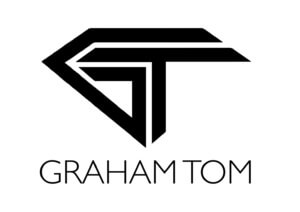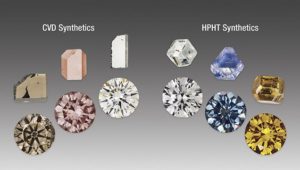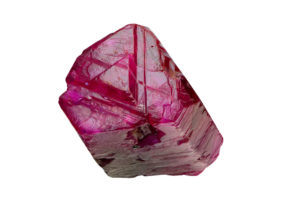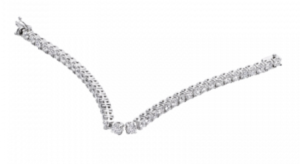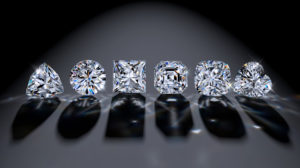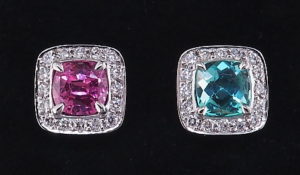Cut of diamond is the most critical of the 4C’s, the variables governing value of diamond and refers to the proportions, symmetry and polish of diamond. Diamonds are a transparent gemstone and dependent on the size of facets to diamond, interacts with transmitted light to create internally reflective, dispersive, refractive and scintillation brilliance.
The term cut must not be confused with the actual shape of diamond which refers to the outline of varying shapes of diamond such as Round Brilliant, Cushion, Emerald, Asscher and Princess cut diamond.
The term cut of diamond refers to the only variable of the 4C’s which is influenced by hand, as Carat weight, Colour and Clarity are all governed by nature via the billion year growth process of rough diamond. To understand cut in more detail, the polisher has a crucial role in realising the ideal diamond cut which is decided by the original shape of the rough diamond, location of internal flaws or inclusions, the preservation of carat weight and popularity of certain shapes amongst consumers. The polisher must consider each of these variables before proceeding.
Rough diamond and yield of polished diamond
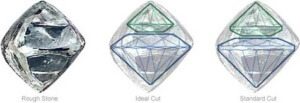
The polisher has to decide whether to yield from the rough crystal above, the ideal proportions for a diamond to realise maximum brilliance , as per Ideal cut above or compromise with a spreadier, heavier weighted Standard cut with a smaller crown and weaker brilliance.
So diamonds are actually cut to preserve as much weight as possible as a heavier carat weight could be more attractive to a consumer however the cost per stone increases and the cut grade would be weaker due to deviation from ideal proportions. If the polisher adhered to ideal proportions a better cut grade would be issued by a grading laboratory. Cut grade is so important as it allows the buyer to identify diamonds that have not been cut to ideal proportions.
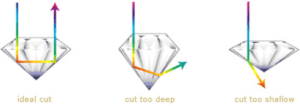
Diamond proportions
A diamond cut has to have harmony between diameter, crown height, depth, crown, pavilion angles and girdle, referred to as proportions. The table and depth percentages both represent a percentage of the girdle diameter and also affects how light travels within diamond which can impact on the brilliance of diamond.
If you revert to ideal cut above the ideal proportions allow light to strike each pavilion facet at an angle to reflect back to crown and light refracts on exit enabling dispersive brilliance.
If you revert to cut too deep light strikes the first pavilion facet at an angle sharp enough to reflect to the second pavilion. However, the light strikes the second pavilion at too low an angle, causing the light to refract through the bottom of the diamond, a diamond will appear dull or dark.
If you revert to cut too shallow, light strikes the first pavilion facet at a low angle and passes through facet and refracts through bottom of diamond, a shallow cut diamond will lose brilliance.
A well proportioned diamond will have each facet properly placed and angled so as to maximize the amount of light that reflects back out of the crown of the diamond to viewer. This reflected light is called reflected internal, dispersive (fire) and scintillation brilliance (sparkle).
A diamond cut has to have harmony between diameter, crown height, depth, crown, pavilion angles and girdle, referred to as proportions. The table and depth percentages both represent a percentage of the girdle diameter and also affects how light travels within diamond which can impact on the brilliance of diamond.
If you revert to ideal cut above the ideal proportions allow light to strike each pavilion facet at an angle to reflect back to crown and light refracts on exit enabling dispersive brilliance.
If you revert to cut too deep light strikes the first pavilion facet at an angle sharp enough to reflect to the second pavilion. However, the light strikes the second pavilion at too low an angle, causing the light to refract through the bottom of the diamond, a diamond will appear dull or dark.
If you revert to cut too shallow, light strikes the first pavilion facet at a low angle and passes through facet and refracts through bottom of diamond, a shallow cut diamond will lose brilliance.
A well proportioned diamond will have each facet properly placed and angled so as to maximize the amount of light that reflects back out of the crown of the diamond to viewer. This reflected light is called reflected internal, dispersive (fire) and scintillation brilliance (sparkle).
A diamond cut has to have harmony between diameter, crown height, depth, crown, pavilion angles and girdle, referred to as proportions. The table and depth percentages both represent a percentage of the girdle diameter and also affects how light travels within diamond which can impact on the brilliance of diamond.
If you revert to ideal cut above the ideal proportions allow light to strike each pavilion facet at an angle to reflect back to crown and light refracts on exit enabling dispersive brilliance.
If you revert to cut too deep light strikes the first pavilion facet at an angle sharp enough to reflect to the second pavilion. However, the light strikes the second pavilion at too low an angle, causing the light to refract through the bottom of the diamond, a diamond will appear dull or dark.
If you revert to cut too shallow, light strikes the first pavilion facet at a low angle and passes through facet and refracts through bottom of diamond, a shallow cut diamond will lose brilliance.
A well proportioned diamond will have each facet properly placed and angled so as to maximize the amount of light that reflects back out of the crown of the diamond to viewer. This reflected light is called reflected internal, dispersive (fire) and scintillation brilliance (sparkle).
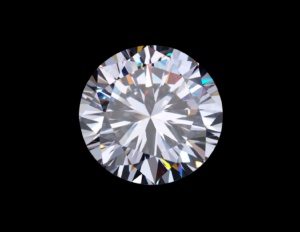
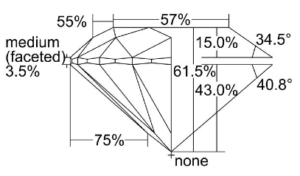
GIA Grading Reports
To understand diamond cut we all know that diamonds are renowned for their ability to transmit light and sparkle. GIA laboratory services take a view a diamond’s cut grade is really about how well a diamond’s facets interact with light.
To determine the cut grade of the standard round brilliant diamond, the shape that dominates the majority of diamond jewellery, GIA calculates the proportions of those facets that influence the diamond’s face-up appearance. These proportions allow GIA to evaluate how successfully a diamond interacts with light to create desirable visual effects such as:
Brightness: Internal and external white light reflected from a diamond.
Fire: The scattering of white light into all the colors of the rainbow.
Scintillation: The amount of sparkle a diamond produces, and the pattern of light and dark areas caused by reflections within the diamond.
GIA’s diamond cut grade also takes into account the design and craftsmanship of the diamond, including its weight relative to its diameter, its girdle thickness which affects its durability, the symmetry of its facet arrangement, and the quality of polish on those facets. These two variables are called the finish of diamond which I will address in another blog.
GIA employs cut grades ranging from Excellent/Very Good/Good/Fair/Poor. Excellent Cut is granted to diamonds with the highest level of brightness, fire and scintillation while the lower gradings of cut are granted to stones with poorer light reflection, fire and scintillation.
GIA only grade cut for round brilliant cut diamonds and not fancy cut diamonds due to the nuances in proportions and measurements which can vary considerably.
At Graham Tom, we only sell diamonds for our bespoke jewellery services accompanied with either a GIA dossier or a GIA grading report as we believe in the consistency and accuracy of GIA’s grading standards.
